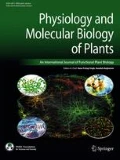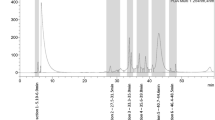Abstract
The root bark of Semialarium mexicanum (Miers) Mennega (cancerina) is traditionally used in Mexico to treat cancer. However, there are no studies supporting its use. We evaluated whether S. mexicanum root bark induces cytotoxicity in breast cancer cells to determine if it has potential applications in the treatment of this disease. Extracts of S. mexicanum root bark in petroleum ether, ethanol, and water were obtained by ultrasound-assisted extraction. MTT and WST-1 assays were used to evaluate the cytotoxicity of the extracts toward breast cancer cells (MDA-MB-231 and MCF7), non-tumorigenic breast-derived cells (MCF 10A), and peripheral blood mononuclear cells (PBMCs). For the extract with greatest cytotoxicity, induction of apoptosis and oxidative stress were determined using flow cytometry. The extract was fractionated, and the cytotoxicity of its fractions was evaluated with the four cell types. The fractions were also analyzed by HPLC. Only the petroleum ether extract was cytotoxic for all cell types (MDA-MB-231 > MCF 10A/MCF7 > PBMCs). Cell death occurred by apoptosis, which could be associated with the induction of oxidative stress. Two fractions that were highly cytotoxic for breast cancer cells were obtained from this extract (IC50 ≤ 4.15 µg/mL for the most active fraction at 72 h). The MCF 10A cells were less affected, while PBMCs were not affected after 72 h of treatment. Pristimerin was identified in both fractions and may be partially responsible for the cytotoxic effect. These results suggest that S. mexicanum root bark has a potential application in breast cancer treatment.










Similar content being viewed by others
References
Alexandre J, Hu Y, Lu W, Pelicano H, Huang P (2007) Novel action of paclitaxel against cancer cells: bystander effect mediated by reactive oxygen species. Cancer Res 67:3512–3517. https://doi.org/10.1158/0008-5472.can-06-3914
Alonso-Castro AJ, Villarreal ML, Salazar-Olivo LA, Gomez-Sanchez M, Dominguez F, Garcia-Carranca A (2011) Mexican medicinal plants used for cancer treatment: pharmacological, phytochemical and ethnobotanical studies. J Ethnopharmacol 133:945–972. https://doi.org/10.1016/j.jep.2010.11.055
Araujo Leon J-A, Ruiz Ciau D-V, Coral Martinez T-I, Cantillo Ciau Z-O (2015) Comparative fingerprint analyses of extracts from the root bark of wild Hippocratea excelsa and “Cancerina” by high-performance liquid chromatography. J Sep Sci 38:3870–3875. https://doi.org/10.1002/jssc.201401480
Arjunan V, Subramanian S, Mohan S (2001) Fourier transform infrared and Raman spectral analysis of trans-1,4-polyisoprene. Spectrochim Acta Part A Mol Biomol Spectrosc 57:2547–2554. https://doi.org/10.1016/S1386-1425(01)00426-7
Badisa RB, Darling-Reed SF, Joseph P, Cooperwood JS, Latinwo LM, Goodman CB (2009) Selective cytotoxic activities of two novel synthetic drugs on human breast carcinoma MCF-7 cells. Anticancer Res 29:2993–2996
Bashir AY, Hozeifa MH, Lu-Yong Z, Zhen-Zhou J (2017) Anticancer potential and molecular targets of pristimerin: a mini- review. Curr Cancer Drug Targets 17:100–108. https://doi.org/10.2174/1568009616666160112105824
Cáceres-Castillo D, Mena-Rejón GJ, Cedillo-Rivera R, Quijano L (2008) 21β-Hydroxy-oleanane-type triterpenes from Hippocratea excelsa. Phytochemistry 69:1057–1064. https://doi.org/10.1016/j.phytochem.2007.10.016
Chen D, Shao H, Yao W, Huang B (2013) Fourier transform infrared spectral analysis of polyisoprene of a different microstructure. Int J Polym Sci 2013:5. https://doi.org/10.1155/2013/937284
Cos P, Vlietinck AJ, Berghe DV, Maes L (2006) Anti-infective potential of natural products: How to develop a stronger in vitro ‘proof-of-concept’. J Ethnopharmacol 106:290–302. https://doi.org/10.1016/j.jep.2006.04.003
Dholwani KK, Saluja AK, Gupta AR, Shah DR (2008) A review on plant-derived natural products and their analogs with anti-tumor activity. Indian J Pharmacol 40:49–58. https://doi.org/10.4103/0253-7613.41038
dos Santos KAM, Suarez PAZ, Rubim JC (2005) Photo-degradation of synthetic and natural polyisoprenes at specific UV radiations. Polym Degrad Stab 90:34–43. https://doi.org/10.1016/j.polymdegradstab.2005.01.038
Fitzpatrick FA, Wheeler R (2003) The immunopharmacology of paclitaxel (Taxol®), docetaxel (Taxotere®), and related agents. Int Immunopharmacol 3:1699–1714. https://doi.org/10.1016/j.intimp.2003.08.007
Global Burden of Disease Cancer C (2017) Global, regional, and national cancer incidence, mortality, years of life lost, years lived with disability, and disability-adjusted life-years for 32 cancer groups, 1990 to 2015: a systematic analysis for the global burden of disease study. JAMA Oncol 3:524–548. https://doi.org/10.1001/jamaoncol.2016.5688
Gomes JP, Cardoso CRP, Varanda EA, Molina JM, Fernandez MF, Olea N, Carlos IZ, Vilegas W (2011) Antitumoral, mutagenic and (anti)estrogenic activities of tingenone and pristimerin. Revista Brasileira de Farmacognosia 21:963–971. https://doi.org/10.1590/S0102-695X2011005000153
Kaneno R, Shurin GV, Kaneno FM, Naiditch H, Luo J, Shurin MR (2011) Chemotherapeutic agents in low noncytotoxic concentrations increase immunogenicity of human colon cancer cells. Cell Oncol 34:97–106. https://doi.org/10.1007/s13402-010-0005-5
Mena-Rejón GJ, Pérez-Espadas AR, Moo-Puc RE, Cedillo-Rivera R, Bazzocchi IL, Jiménez-Diaz IA, Quijano L (2007) Antigiardial activity of triterpenoids from root bark of Hippocratea excelsa. J Nat Prod 70:863–865. https://doi.org/10.1021/np060559y
Mullen PJ, Yu R, Longo J, Archer MC, Penn LZ (2016) The interplay between cell signalling and the mevalonate pathway in cancer. Nat Rev Cancer 16:718. https://doi.org/10.1038/nrc.2016.76
Ozben T (2007) Oxidative stress and apoptosis: impact on cancer therapy. J Pharm Sci 96:2181–2196. https://doi.org/10.1002/jps.20874
Popoca J, Al Aguilar, Alonso D, Villarreal ML (1998) Cytotoxic activity of selected plants used as antitumorals in Mexican traditional medicine. J Ethnopharmacol 59:173–177. https://doi.org/10.1016/S0378-8741(97)00110-4
Reyes-Chilpa R, Jiménez-Estrada M, Cristóbal-Telésforo E, Torres-Colín L, Villavicencio MA, Pérez-Escandón BE, Mercado-González R (2003) Natural insecticides from Hippocratea excelsa and Hippocratea celastroides. Econ Bot 57:54–64. https://doi.org/10.1663/0013-0001(2003)057[0054:NIFHEA]2.0.CO;2
Schmid I, Krall WJ, Uittenbogaart CH, Braun J, Giorgi JV (1992) Dead cell discrimination with 7-amino-actinomcin D in combination with dual color immunofluorescence in single laser flow cytometry. Cytometry 13:204–208. https://doi.org/10.1002/cyto.990130216
Seelinger M, Popescu R, Giessrigl B, Jarukamjorn K, Unger C, Wallnöfer B, Fritzer-Szekeres M, Szekeres T, Diaz R, Jäger W, Frisch R, Kopp B, Krupitza G (2012) Methanol extract of the ethnopharmaceutical remedy Smilax spinosa exhibits anti-neoplastic activity. Int J Oncol 41:1164–1172. https://doi.org/10.3892/ijo.2012.1538
Singh M, McKenzie K, Xiaoling M (2017) Effect of dimethyl sulfoxide on in vitro proliferation of skin fibroblast cells. J Biotech Res 8:78–82
Torre LA, Bray F, Siegel RL, Ferlay J, Lortet-Tieulent J, Jemal A (2015) Global cancer statistics, 2012. CA Cancer J Clin 65:87–108. https://doi.org/10.3322/caac.21262
Varbiro G, Veres B, Gallyas F, Sumegi B (2001) Direct effect of Taxol on free radical formation and mitochondrial permeability transition. Free Radic Biol Med 31:548–558. https://doi.org/10.1016/S0891-5849(01)00616-5
Wang TH, Wang HS, Soong YK (2000) Paclitaxel-induced cell death. Cancer 88:2619–2628. doi: 10.1002/1097-0142(20000601)88:11<2619:aid-cncr26>3.0.co;2-j
Wen J, Tong Y, Zu Y (2015) Low concentration DMSO stimulates cell growth and in vitro transformation of human multiple myeloma cells. Br J Med Med Res 5:65–74. https://doi.org/10.9734/BJMMR/2015/5276
Yadav N, Kumar S, Marlowe T, Chaudhary AK, Kumar R, Wang J, O’Malley J, Boland PM, Jayanthi S, Kumar TKS, Yadava N, Chandra D (2015) Oxidative phosphorylation-dependent regulation of cancer cell apoptosis in response to anticancer agents. Cell Death Dis 6:e1969. https://doi.org/10.1038/cddis.2015.305
Zhang L, Yu Y, Joubert C, Bruder G, Liu Y, Chang CC, Simon M, Walker S, Rafailovich M (2016) Differentiation of dental pulp stem cells on gutta-percha scaffolds. Polymers 8:193. https://doi.org/10.3390/polym8050193
Acknowledgements
This work was supported by the Instituto Politécnico Nacional and the National Council of Science and Technology, Mexico (CONACYT, Proyecto de Cátedras No. 1728).
Author information
Authors and Affiliations
Contributions
ESMM, JM-C, CNQ-R and RGC-P conceived, designed and performed the experiments. JM-C, CNQ-R and RGC-P analyzed the data. ESMM contributed with reagents, materials and analysis tools. JM-C, RGC-P, CNQ-R and ESMM wrote the manuscript.
Corresponding author
Ethics declarations
Conflict of interest
The authors declare that they have no conflict of interest.
Rights and permissions
About this article
Cite this article
Maldonado-Cubas, J., San Martin-Martínez, E., Quiroz-Reyes, C.N. et al. Cytotoxic effect of Semialarium mexicanum (Miers) Mennega root bark extracts and fractions against breast cancer cells. Physiol Mol Biol Plants 24, 1185–1201 (2018). https://doi.org/10.1007/s12298-018-0580-x
Received:
Revised:
Accepted:
Published:
Issue Date:
DOI: https://doi.org/10.1007/s12298-018-0580-x




